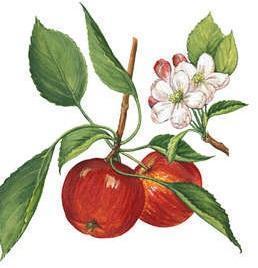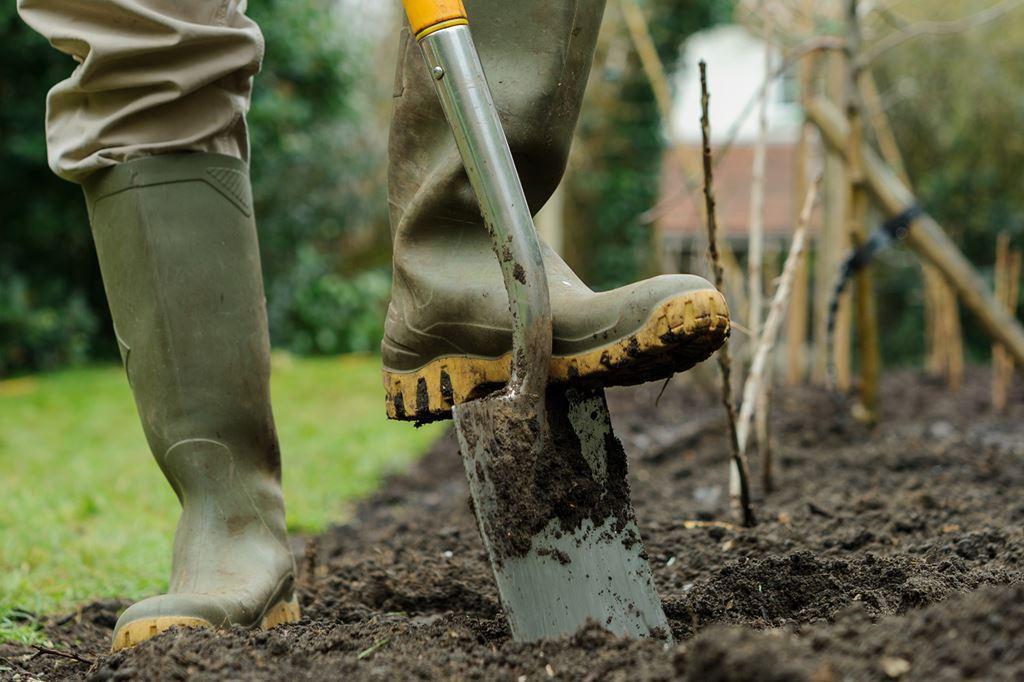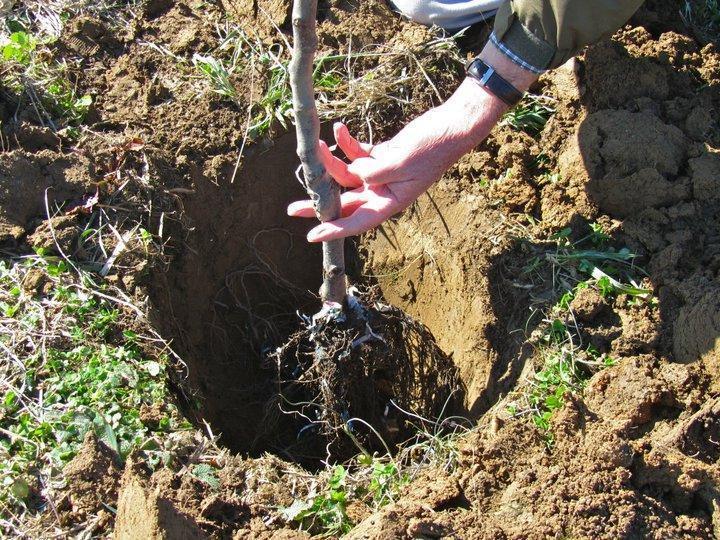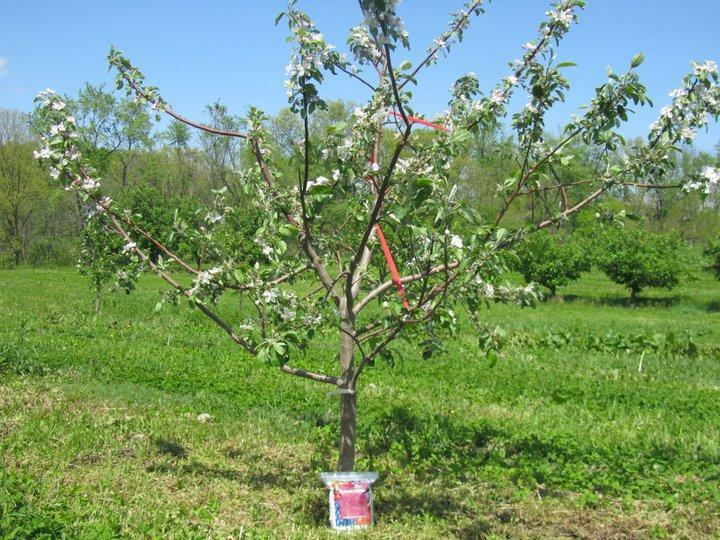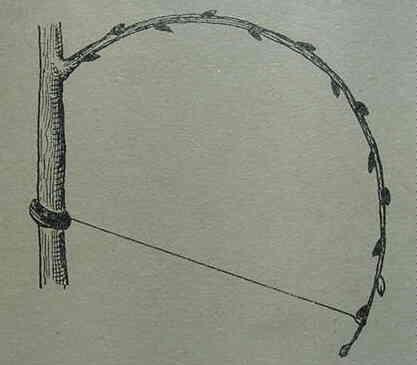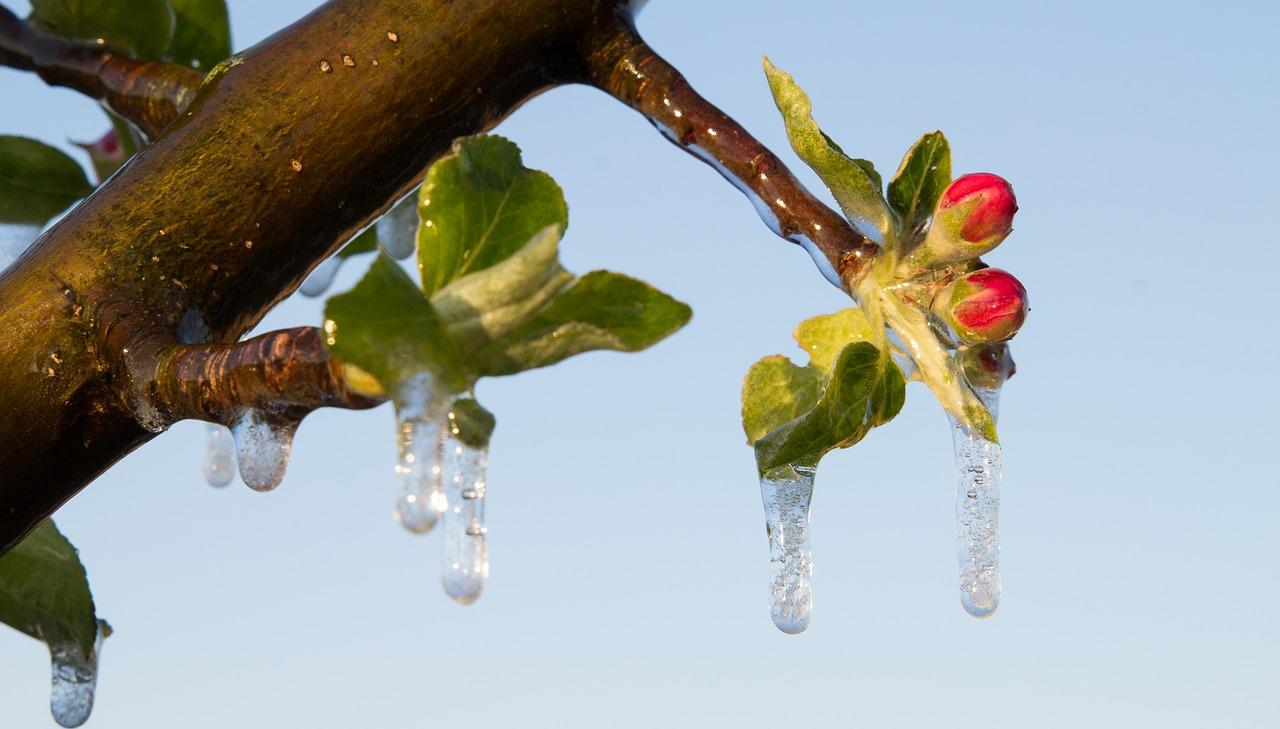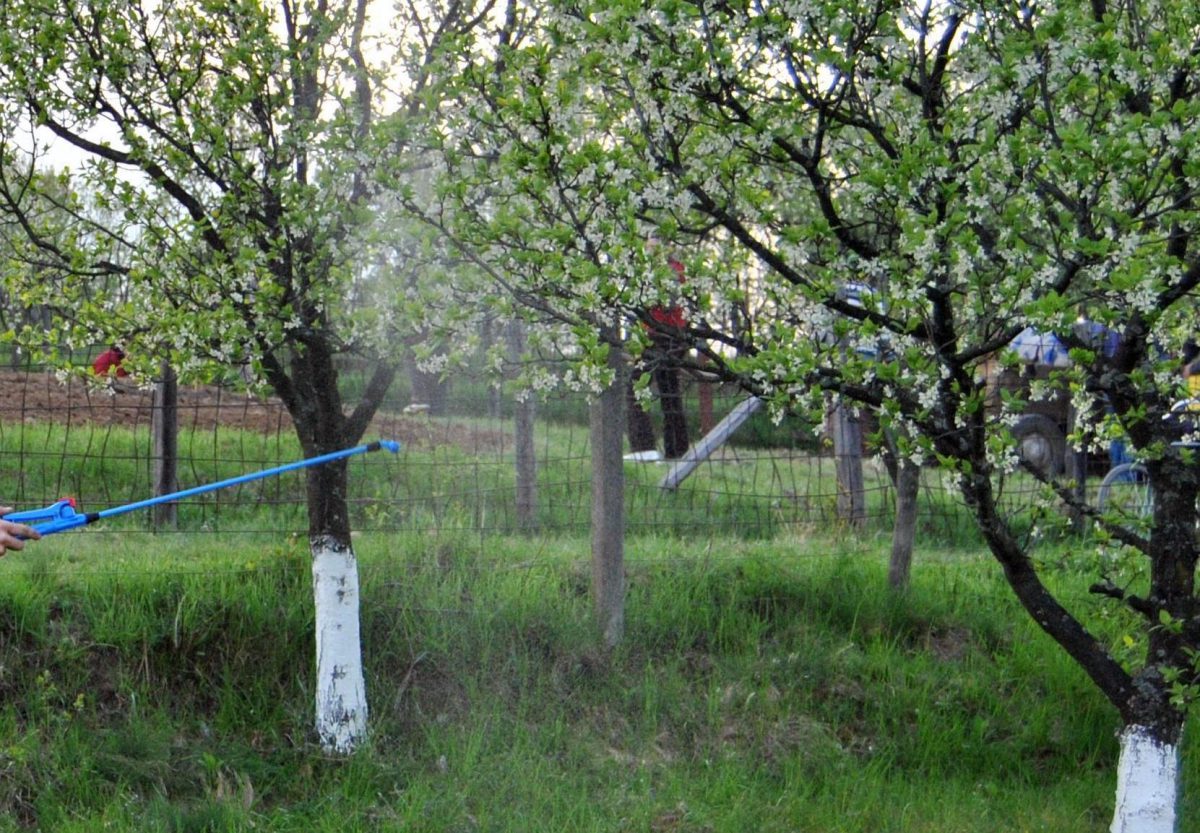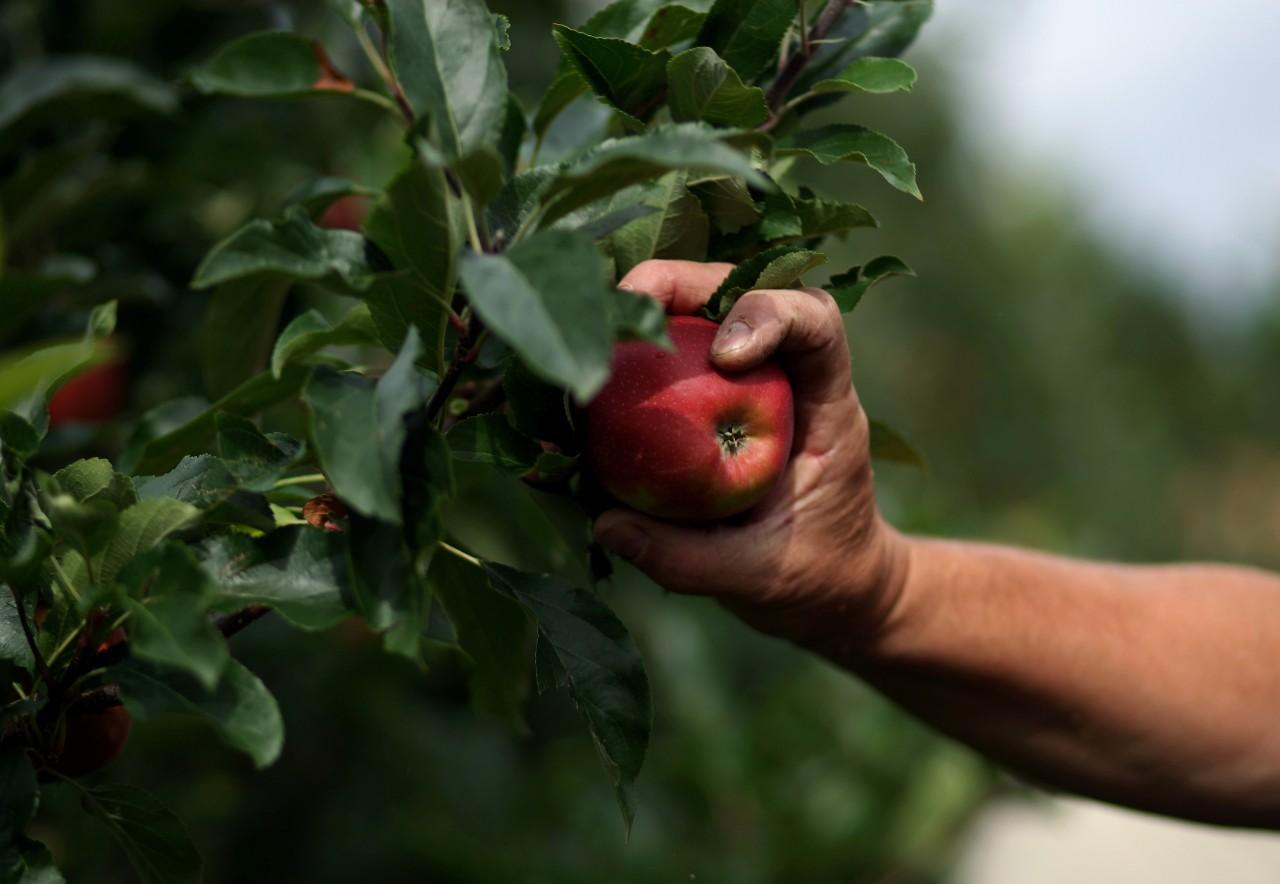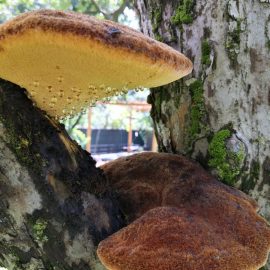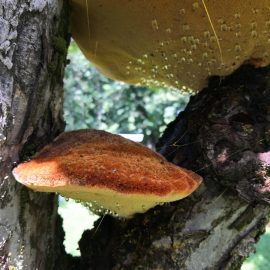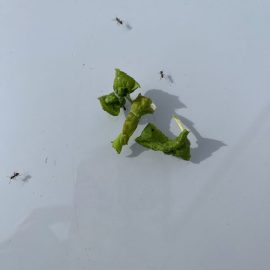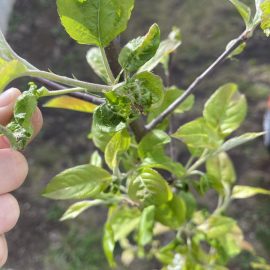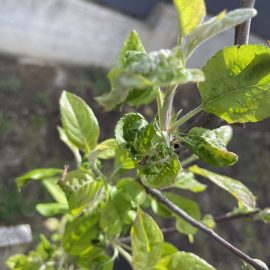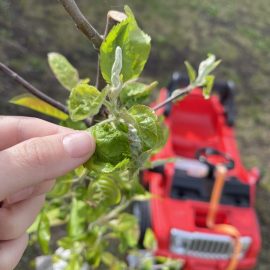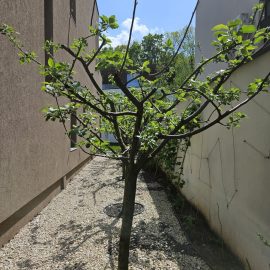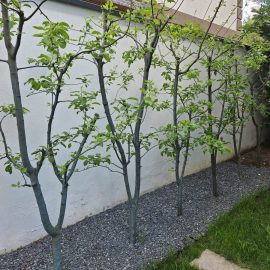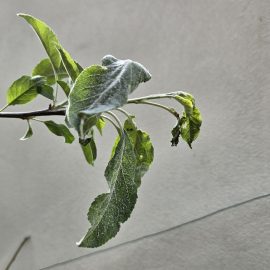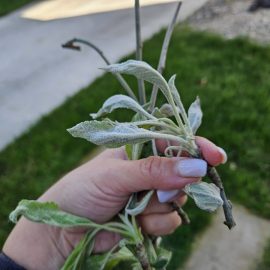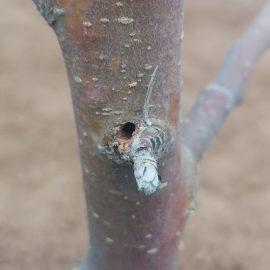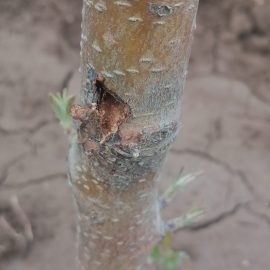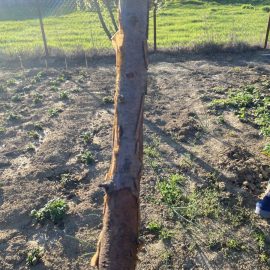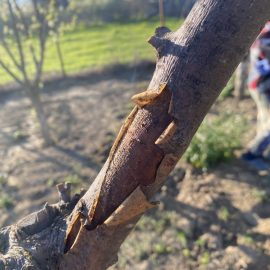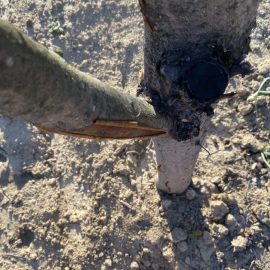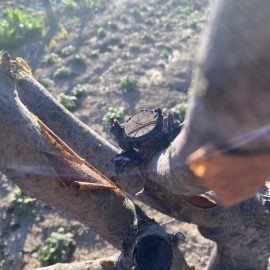Apple tree, planting, growing and harvesting
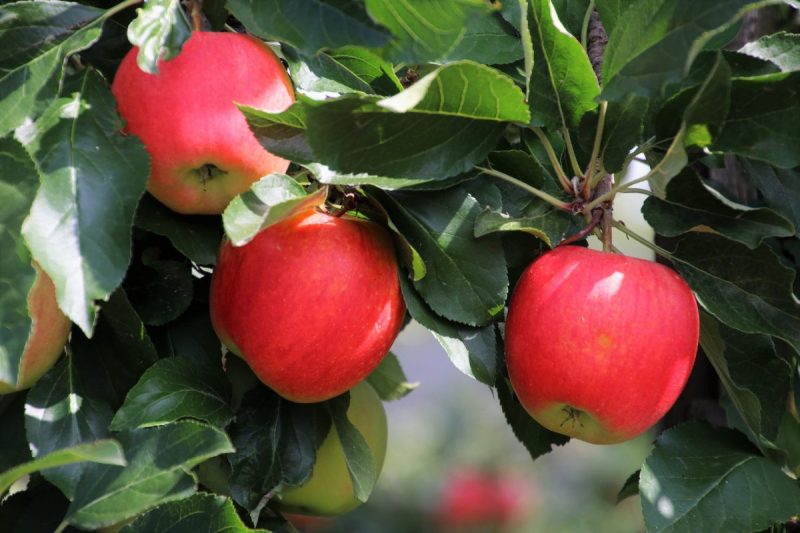
Apple tree (Malus domestica) – it is an easy-care fruit tree that does not require special operations. It has a relatively small trunk and a broadly branched crown. Apple leaves are oval and alternately arranged. The apple tree blossoms consist of five white petals with a slight hint of pink. Apple has in its composition a series of nutrients and important elements: sugars, vitamins (A, B1, B2, C), iron, phosphorus, calcium, and magnesium, and their amount is higher in the peel than in the pulp.
Growing and fruiting particularities
The root system development is influenced by the rootstock used. High-vigor trees will explore a large mass of soil. Dwarf apple trees have a shallow anchorage, and under certain conditions need additional support. The apple tree root system has continuous growth, and most of the roots are found at a depth of 60-70 cm.
Vegetative buds are small and thin. Mixed and flowering buds are large and rounded. From a mixed bud forms a rosette of leaves and an inflorescence. The apple blossoms relatively late, without being affected (in normal years) by late frosts.
Climate and soil requirements
The apple has moderate light requirements. The apple tree grows well in areas with average annual temperatures between 8 and 11 ° C. Buds start growing at temperatures above 8 °C and flowers open at temperatures above 11 °C. The optimum temperature range for an apple tree is 14-27 °C. Good results are obtained in areas with 700-900 mm rainfall per year (winter varieties) or 500-600 mm (summer/autumn varieties). The apple tree can grow well in different types of soil, but it grows best on deep, fertile clay or loam soils. Also, groundwater should not be less than 2.5 meters deep.
Soil preparation
Establishing an orchard starts with choosing and preparing the land. Generally, apple trees grow and develop well in hilly and hilly areas. The soil preparation should be done at least 3 months before planting. Thus, the soil accumulates water and restores its structure. If the apple plantation is established on land that has been used as an orchard, the soil should be prepared 1-2 years in advance.
To eliminate infection outbreaks, the land can be cultivated with perennial or annual legumes (peas, alfalfa, clover, etc.). They enrich the soil with nitrogen and restore the soil structure. If the ground is heavily infested with weeds, you can apply a non-selective herbicide.
Recommended products
-
You can find products on a different store
Change Store -
You can find products on a different store
Change Store -
You can find products on a different store
Change Store -
You can find products on a different store
Change Store -
You can find products on a different store
Change Store -
You can find products on a different store
Change Store -
You can find products on a different store
Change Store -
You can find products on a different store
Change Store -
You can find products on a different store
Change Store -
You can find products on a different store
Change Store -
You can find products on a different store
Change Store -
You can find products on a different store
Change Store -
You can find products on a different store
Change Store -
You can find products on a different store
Change Store -
You can find products on a different store
Change Store -
You can find products on a different store
Change Store -
You can find products on a different store
Change Store -
You can find products on a different store
Change Store -
You can find products on a different store
Change Store -
You can find products on a different store
Change Store -
You can find products on a different store
Change Store -
You can find products on a different store
Change Store -
You can find products on a different store
Change Store -
You can find products on a different store
Change Store
The soil can be fertilized with organic fertilizers (manure, compost). It is recommended to scarify the soil so that the roots grow easily. All foreign matter in the soil should be collected and removed from the plot, after which the land must be well-leveled.
For precise planting, the land can be picketed. Picketing is the process of marking the position of each apple tree on the ground. Specifically, a stake is inserted into the tree planting site.
Planting
It is good to find out in advance which apple variety is best suited to the climatic conditions in your area. The seedlings should be bought from authorized nurseries.
At the time of planting the trees must be dormant and the soil must not be frozen. Generally, in areas with mild winters, autumn planting is most recommended. Apple seedlings planted in the fall will benefit from water accumulated during rainy periods and melting snow and will start growing in early spring. In areas with cold winters and low rainfall, spring planting is preferred. You can do this work before budbreak.
Before planting, the roots should be trimmed.
To stimulate root development, the roots should be trimmed. The operation is performed to remove the damaged portions and to maintain a healthy root system. Necrotic roots must be completely removed, and the healthy ones must be shortened by 7-8 cm. Trimming must be done only if the apple saplings have been recently removed from the ground.
After trimming, the roots must be soaked. Mudding means dipping the root into a mixture of yellow soil, fresh manure, and water. The mud layer helps the tree to adapt to the new soil conditions and maintains the moisture around the roots.
Actual planting
In the intensive system, the most applied planting distances are 4 meters distance between rows and 2 meters distance between trees per row. The planting pit can have a depth of about 25-30 cm. At the base of the pit, you can introduce fertile soil (from the surface of the pit) mixed with well-fermented manure.
The saplings must be planted so that the grafting point is 10-15 cm above the ground. When the roots have been covered with about 10 cm of soil, carry out the first tamping (from the edge to the center). When planting, the roots must be in close contact with the soil. After planting, apply fertilizers by incorporating and watering the soil abundantly. Repeat watering whenever needed. Insert a stake next to the sapling, for additional support. After planting, the saplings should be shortened to a height of 80 cm. The sapling can be covered with rodent protection materials.
Care works
Drought can set in early spring, and apple saplings are sensitive to water shortages, so to prevent losses, the orchard should be irrigated (if necessary). The area around the fruit trees can be covered with a layer of mulch (straw manure). Mulching maintains a good phytosanitary condition, prevents the development of weeds, and reduces the number of crop maintenance works.
Pruning
For crown formation and maintenance, the apple tree must be pruned annually. Mainly, pruning should ensure:
- balance between growth and fruition;
- ensuring light penetration into the crown;
- crown lateral branching;
- production quality.
Recommended products
-
You can find products on a different store
Change Store -
You can find products on a different store
Change Store -
You can find products on a different store
Change Store -
You can find products on a different store
Change Store -
You can find products on a different store
Change Store -
You can find products on a different store
Change Store -
You can find products on a different store
Change Store -
You can find products on a different store
Change Store -
You can find products on a different store
Change Store -
You can find products on a different store
Change Store -
You can find products on a different store
Change Store -
You can find products on a different store
Change Store -
You can find products on a different store
Change Store -
You can find products on a different store
Change Store -
You can find products on a different store
Change Store -
You can find products on a different store
Change Store -
You can find products on a different store
Change Store -
You can find products on a different store
Change Store -
You can find products on a different store
Change Store -
You can find products on a different store
Change Store -
You can find products on a different store
Change Store -
You can find products on a different store
Change Store -
You can find products on a different store
Change Store -
You can find products on a different store
Change Store
In the spring, all twigs must be removed from the stem up to a height of 60 cm.
Leave three twigs evenly arranged on the central axis in the upper part of the tree (60-80 cm). In the second year (spring) the 3 selected twigs should be shortened to 30-40 cm. The central axis should be shortened so that it is 20-30 cm longer than the side twigs. In the third spring, the three main branches must be shortened to 70 cm. The central axis must be cut above an outward-facing bud so that it is 25 cm higher than the main branches. The twigs that grow on the central axis and the main branches must be cut at 15-20 cm (4-5 buds).
At the top of each branch, you should form 4-5 strong twigs.
Choose two extension twigs for each branch. They must be facing outwards and not intersect. The other twigs should be shortened to 4-5 buds. All growth on the branches must be removed. On the central axis, choose 3-4 twigs that will form the second layer of the crown. They must be 70 cm away from the first layer. The branches chosen to form the second layer must be shortened to 60-70 cm. Then, cut the central axis 25 cm above the second layer of the crown. All branches that intersect, shade each other, or grow inside the crown must be removed. The crown should be as close as possible to the trunk and have a triangular shape. Thus, solar radiation is used to the maximum.
In the apple tree case, the fruiting buds are large and have a swollen barrel-like appearance.
They are located at the top of the fruiting branches. These branches can be short or long. The branches that do not bear flower buds at the top are vegetative branches. Maintenance pruning consists of shortening and thinning branches older than one year, thinning fruiting branches, and removing or shortening vegetative branches. The crown must be kept aerated. Water sprouts and branches growing inside the crown must be removed. If part of the fruit is not removed, the branches may break under their weight, and in the next year, they will no longer produce fruit.
Pruning during summer (July-August)
Remove the tips of the young twigs. This causes the buds below the cutting spot to develop. Also during this period, the twigs should be removed. The operation consists of cutting off the base of the twig grown in inappropriate positions. All cuts must be made at an angle of 45 degrees and wounds larger than 2 cm must be covered with tree wound sealer. This will allow water to drain easily from the wound.
Recommended products
-
You can find products on a different store
Change Store -
You can find products on a different store
Change Store -
You can find products on a different store
Change Store -
You can find products on a different store
Change Store -
You can find products on a different store
Change Store -
You can find products on a different store
Change Store -
You can find products on a different store
Change Store -
You can find products on a different store
Change Store -
You can find products on a different store
Change Store -
You can find products on a different store
Change Store -
You can find products on a different store
Change Store -
You can find products on a different store
Change Store -
You can find products on a different store
Change Store -
You can find products on a different store
Change Store -
You can find products on a different store
Change Store -
You can find products on a different store
Change Store -
You can find products on a different store
Change Store -
You can find products on a different store
Change Store -
You can find products on a different store
Change Store -
You can find products on a different store
Change Store -
You can find products on a different store
Change Store -
You can find products on a different store
Change Store -
You can find products on a different store
Change Store -
You can find products on a different store
Change Store
Changing the branch’s position
- Branch training: represents the change of natural position of the branches, towards the vertical. This causes the branch to grow and strengthen. This operation should carried out mainly in the mature phase of the trees. In this phase, the vegetative growth ceases and this operation leads to crown rejuvenation.
- Branch tying down: it consists in changing the position of the branches, towards the horizontal. This causes the buds on the branch to differentiate and aerates the crown. Branches can be tied down below the horizontal to obtain abundant fruiting. This operation is practiced in the young stage of the trees when vegetative growth is predominant.
- Branch arching: through this change of position, the basal part remains ascending, and the terminal part is inclined below the horizontal (descent). This operation stops or slows down the growth in length of the branch and promotes bud growth. Trees that have been arched begin to bear fruit 2-3 years earlier.
For the same purpose, several secondary technical operations can be performed.
- Transverse incision: represents the disruption of the vessels by a fine cut with a sharp blade. The cut must be made above a bud;
- Longitudinal incision: represents a fine cut along the length of the trunk. This operation helps to increase the thickness of the trunk;
- Twisting: consists of twisting a branch or twig. This operation stimulates fruiting;
- Branch breaking: it is practiced in the case of branches that have an inappropriate orientation. Fruiting occurs quickly on broken branches.
Weed control
The interval between rows must be kept clean. Weeds can be cut with a weed cutter to add organic matter to the soil or removed chemically. Spraying should be done with approved products, carefully so that the spray does not get on the apple leaves. During the first three years after planting do not use herbicides.
Recommended products
-
You can find products on a different store
Change Store -
You can find products on a different store
Change Store -
You can find products on a different store
Change Store -
You can find products on a different store
Change Store -
You can find products on a different store
Change Store -
You can find products on a different store
Change Store -
You can find products on a different store
Change Store -
You can find products on a different store
Change Store -
You can find products on a different store
Change Store -
You can find products on a different store
Change Store -
You can find products on a different store
Change Store -
You can find products on a different store
Change Store -
You can find products on a different store
Change Store -
You can find products on a different store
Change Store -
You can find products on a different store
Change Store -
You can find products on a different store
Change Store -
You can find products on a different store
Change Store -
You can find products on a different store
Change Store -
You can find products on a different store
Change Store -
You can find products on a different store
Change Store -
You can find products on a different store
Change Store -
You can find products on a different store
Change Store -
You can find products on a different store
Change Store -
You can find products on a different store
Change Store
Protecting trees from frost
When low temperatures are announced, in the orchard, you can burn easily burning materials (gathered in piles), which produces a large amount of smoke (rubber, straw, manure, tar, peat, etc.). Thus, the smoke layer that forms above the orchard does not allow heat to be released from the soil and thus maintains a higher temperature at the trunk/tree crown level. It is important to keep the fire on throughout the night, especially before sunrise, when temperatures drop sharply. This operation can protect the trees from temperatures down to -3 °C.
Fertilization
Apple trees react well to organic fertilizers (manure, granular fertilizers), periodically, every 2-3 years. Besides basic fertilization, you can also apply foliar fertilizers periodically during the growing season. Fertilization (dosage, ratio of elements) should be done only after a chemical analysis of the soil.
Recommended products
-
You can find products on a different store
Change Store -
You can find products on a different store
Change Store -
You can find products on a different store
Change Store -
You can find products on a different store
Change Store -
You can find products on a different store
Change Store -
You can find products on a different store
Change Store -
You can find products on a different store
Change Store -
You can find products on a different store
Change Store -
You can find products on a different store
Change Store -
You can find products on a different store
Change Store -
You can find products on a different store
Change Store -
You can find products on a different store
Change Store -
You can find products on a different store
Change Store -
You can find products on a different store
Change Store -
You can find products on a different store
Change Store -
You can find products on a different store
Change Store -
You can find products on a different store
Change Store -
You can find products on a different store
Change Store -
You can find products on a different store
Change Store -
You can find products on a different store
Change Store -
You can find products on a different store
Change Store -
You can find products on a different store
Change Store -
You can find products on a different store
Change Store -
You can find products on a different store
Change Store
Irrigation
Because the apple tree is a species with high water requirements, irrigation is mandatory in young orchards, especially in areas with a lack of rainfall. The best results are obtained using drip irrigation.
Fruit thinning
It is an important operation. The work aims to improve production both in terms of quality and quantity. This process releases the tension accumulated in the branches due to fruit weight, ensures aeration, and allows the fruit to reach the specific characteristics of the variety (size, color, taste). Keep the fruits healthy, and positioned in the sunlight. Remove all deformed, diseased, or poorly developed fruit.
Pests and disease control
The plantation’s phytosanitary condition is very important. Carrying out phytosanitary treatments according to a specific schedule can significantly reduce the occurrence of diseases and pests.
At the same time, keep the orchard clean. Pick up fallen leaves or branches and cover the trees with special solutions.
To destroy outbreaks of infection in the orchard, apply treatments during the dormant period. Treatments should be applied in autumn/winter when the temperature is above 5 °C.
Against diseases, the first treatment (after leaf fall) should be done with copper-based products. The second spraying with copper-based products must be done in spring, at bud break. The solution should be sprayed all over the tree, from the base of the tree to the branches. These treatments need to be applied on days without rainfall, with temperatures above 6-7° C, so the solution does not freeze on the trees. 7-10 days after applying the copper treatments, apply a horticultural oil treatment, which acts against pests that may overwinter in the bark of the tree.
Recommended products
-
You can find products on a different store
Change Store -
You can find products on a different store
Change Store -
You can find products on a different store
Change Store -
You can find products on a different store
Change Store -
You can find products on a different store
Change Store -
You can find products on a different store
Change Store -
You can find products on a different store
Change Store -
You can find products on a different store
Change Store -
You can find products on a different store
Change Store -
You can find products on a different store
Change Store -
You can find products on a different store
Change Store -
You can find products on a different store
Change Store -
You can find products on a different store
Change Store -
You can find products on a different store
Change Store -
You can find products on a different store
Change Store -
You can find products on a different store
Change Store -
You can find products on a different store
Change Store -
You can find products on a different store
Change Store -
You can find products on a different store
Change Store -
You can find products on a different store
Change Store -
You can find products on a different store
Change Store -
You can find products on a different store
Change Store -
You can find products on a different store
Change Store -
You can find products on a different store
Change Store
Recommended products
-
You can find products on a different store
Change Store -
You can find products on a different store
Change Store -
You can find products on a different store
Change Store -
You can find products on a different store
Change Store -
You can find products on a different store
Change Store -
You can find products on a different store
Change Store -
You can find products on a different store
Change Store -
You can find products on a different store
Change Store -
You can find products on a different store
Change Store -
You can find products on a different store
Change Store -
You can find products on a different store
Change Store -
You can find products on a different store
Change Store -
You can find products on a different store
Change Store -
You can find products on a different store
Change Store -
You can find products on a different store
Change Store -
You can find products on a different store
Change Store -
You can find products on a different store
Change Store -
You can find products on a different store
Change Store -
You can find products on a different store
Change Store -
You can find products on a different store
Change Store -
You can find products on a different store
Change Store -
You can find products on a different store
Change Store -
You can find products on a different store
Change Store -
You can find products on a different store
Change Store
Harvesting
Harvesting must be done at the optimum time for each apple variety. The apple fruit can be harvested by hand, with the stalk, avoiding pulling them off the branches or hitting them. Apples become ripe when they have a characteristic color and detach easily from the branch.
The fruits can be stored in boxes (wooden or plastic), in dark and cool rooms, at temperatures of 0-4 ° C with an air humidity of 80-85%. Under these conditions, the apples can be stored for 3-4 months. The storage place must be checked weekly, and the damaged fruits must be removed. Do not store apples with other fruit or vegetables.














































































































































































































































































































































































































































